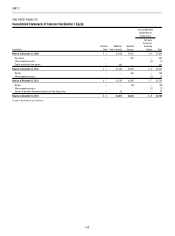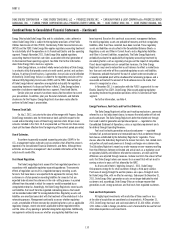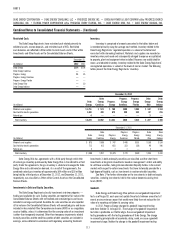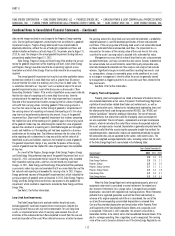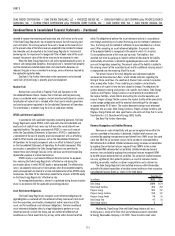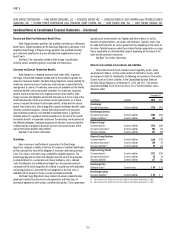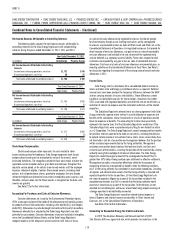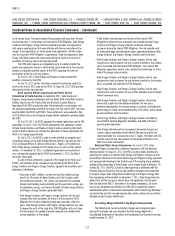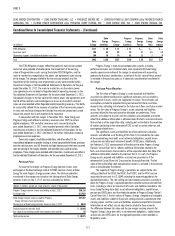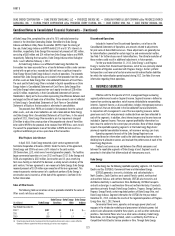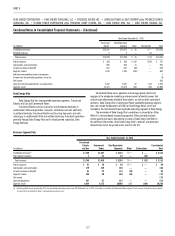Duke Energy 2012 Annual Report Download - page 137
Download and view the complete annual report
Please find page 137 of the 2012 Duke Energy annual report below. You can navigate through the pages in the report by either clicking on the pages listed below, or by using the keyword search tool below to find specific information within the annual report.
117
PART II
Combined Notes to Consolidated Financial Statements – (Continued)
DUKE ENERGY CORPORATION • DUKE ENERGY CAROLINAS, LLC • PROGRESS ENERGY, INC. • CAROLINA POWER & LIGHT COMPANY d/b/a PROGRESS ENERGY
CAROLINAS, INC. • FLORIDA POWER CORPORATION d/b/a PROGRESS ENERY FLORIDA, INC. • DUKE ENERGY OHIO, INC. • DUKE ENERGY INDIANA, INC.
form of ITC or cash grants for renewable energy facilities and renewable
generation property either placed in service through specifi ed dates or for which
construction has begun prior to specifi ed dates. Under the Stimulus Bill, Duke
Energy may elect an ITC, which is determined based on a percentage of the tax
basis of the qualifi ed property placed in service, for property placed in service
after 2008 and before 2014 (2013 for wind facilities) or a cash grant, which
allows entities to elect to receive a cash grant in lieu of the ITC for certain
property either placed in service in 2009 or 2010 or for which construction
begins in 2009 and 2010. In 2010, the Tax Relief, Unemployment Insurance
Reauthorization, and Job Creation Act of 2010 (the 2010 Tax Relief Act) extended
the cash grant program for renewable energy property for one additional year,
through 2011. In 2011, the Budget Control Act of 2011 (BCA) was passed which
provided for an automatic reduction in defense and non-defense spending
beginning January 1, 2013, which could reduce future cash grant payments
since such grants are likely to be treated as non-defense discretionary spending
subject to reduction under the sequester. In 2012, the American Taxpayer
Relief Act of 2012 (the ATRA) extended the ITC (energy credit) and production
tax credits available for wind facilities one year, through 2013, and changed
the timing for determining property eligible for the ITC, from property placed
in service before the credit deadline, to property under construction by the
applicable deadline for the credit. The ATRA delayed the start of the automatic
reductions/sequester under the BCA from January 1 to March 1, 2013. When
Duke Energy elects either the ITC or cash grant on Commercial Power’s wind
or solar facilities that meet the stipulations of the Stimulus Bill, Duke Energy
reduces the basis of the property recorded on the Consolidated Balance
Sheets by the amount of the ITC or cash grant and, therefore, the ITC or grant
benefi t is recognized ratably over the life of the associated asset through
reduced depreciation expense. Additionally, certain tax credits and government
grants received under the Stimulus Bill provide for an incremental initial tax
depreciable base in excess of the carrying value for GAAP purposes, creating
an initial deferred tax asset equal to the tax effect of one half of the ITC or
government grant. Duke Energy records the deferred tax benefi t as a reduction to
income tax expense in the period that the basis difference is created.
Excise Taxes.
Certain excise taxes levied by state or local governments are collected
by the Duke Energy Registrants from their customers. These taxes, which are
required to be paid regardless of the Duke Energy Registrants’ ability to collect
from the customer, are accounted for on a gross basis. When the Duke Energy
Registrants act as an agent, and the tax is not required to be remitted if it is
not collected from the customer, the taxes are accounted for on a net basis.
The Duke Energy Registrants’ excise taxes accounted for on a gross basis and
recorded as operating revenues in the Consolidated Statements of Operations
were as follows:
For the Years Ended December 31,
(in millions) 2012 2011 2010
Duke Energy $466 $293 $300
Duke Energy Carolinas 161 153 156
Progress Energy 317 315 345
Progress Energy Carolinas 113 110 119
Progress Energy Florida 205 205 226
Duke Energy Ohio 102 109 115
Duke Energy Indiana 33 31 29
Foreign Currency Translation.
The local currencies of Duke Energy’s foreign operations have been
determined to be their functional currencies, except for certain foreign operations
whose functional currency has been determined to be the U.S. Dollar, based on an
assessment of the economic circumstances of the foreign operation. Assets and
liabilities of foreign operations, except for those whose functional currency is the
U.S. Dollar, are translated into U.S. Dollars at the exchange rates in effect at period
end. Translation adjustments resulting from fl uctuations in exchange rates are
included as a separate component of AOCI. Revenue and expense accounts of these
operations are translated at average exchange rates prevailing during the year. Gains
and losses arising from balances and transactions denominated in currencies other
than the functional currency are included in the results of operations in the period in
which they occur.
Di vidend Restrictions and Unappropriated Retained Earnings.
Duke Energy does not have any legal, regulatory or other restrictions on
paying common stock dividends to shareholders. However, as further described
in Note 4, due to conditions established by regulators at the time of the Duke
Energy/Cinergy merger in April 2006 and the Duke Energy/Progress Energy
merger in 2012, certain wholly owned subsidiaries, including Duke Energy
Carolinas, Progress Energy Carolinas, Duke Energy Ohio and Duke Energy
Indiana, have restrictions on paying dividends or otherwise advancing funds
to Duke Energy. At December 31, 2012 and 2011, an insignifi cant amount of
Duke Energy’s consolidated Retained earnings balance represents undistributed
earnings of equity method investments.
New Accounting Standards.
The following new accounting standards were adopted by the Duke Energy
Registrants during the year ended December 31, 2012, and the impact of such
adoption, if applicable, has been presented in the accompanying Consolidated
Financial Statements:
Financial Accounting Standards Board (FASB) Accounting
Standards Codifi cation (ASC) 220 — Comprehensive Income. In
June 2011, the FASB amended the existing requirements for presenting
comprehensive income in fi nancial statements primarily to increase the
prominence of items reported in other comprehensive income (OCI) and to
facilitate the convergence of U.S. GAAP and International Financial Reporting
Standards (IFRS). Specifi cally, the revised guidance eliminates the option
previously provided to present components of OCI as part of the statement
of changes in stockholders’ equity. Accordingly, all non-owner changes in
stockholders’ equity are required to be presented either in a single continuous
statement of comprehensive income or in two separate but consecutive
fi nancial statements. For the Duke Energy Registrants, this revised guidance
was effective on a retrospective basis for interim and annual periods beginning
January 1, 2012. The adoption of this standard changed the presentation of the
Duke Energy Registrants’ fi nancial statements but did not affect the calculation
of net income, comprehensive income or earnings per share.
ASC 820 — Fair Value Measurements and Disclosures. In May 2011,
the FASB amended existing requirements for measuring fair value and for
disclosing information about fair value measurements. This revised guidance
results in a consistent defi nition of fair value, as well as common requirements
for measurement and disclosure of fair value information between U.S. GAAP
and IFRS. In addition, the amendments set forth enhanced disclosure
requirements with respect to recurring Level 3 measurements, nonfi nancial



